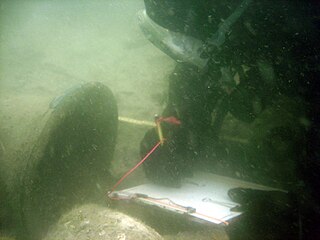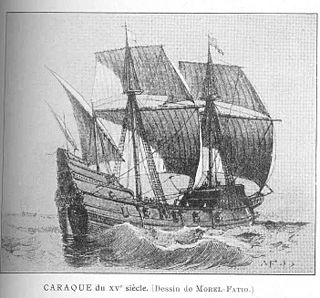
Maritime archaeology is a discipline within archaeology as a whole that specifically studies human interaction with the sea, lakes and rivers through the study of associated physical remains, be they vessels, shore-side facilities, port-related structures, cargoes, human remains and submerged landscapes. A specialty within maritime archaeology is nautical archaeology, which studies ship construction and use.

A shipwreck is the remains of a ship that has wrecked, which are found either beached on land or sunken to the bottom of a body of water. Shipwrecking may be deliberate or accidental. In January 1999, Angela Croome estimated that there have been about three million shipwrecks worldwide.

The Penobscot Expedition was a 44-ship American naval task force mounted during the Revolutionary War by the Provincial Congress of the Province of Massachusetts Bay. The flotilla of 19 warships and 25 smaller support vessels sailed from Boston on July 19, 1779 for the upper Penobscot Bay in the District of Maine carrying a ground expeditionary force of more than 1,000 colonial Marines and militiamen. Also included was a 100-man artillery detachment under the command of Lt. Colonel Paul Revere. The Expedition's goal was to reclaim control of what is now mid-coast Maine from the British who had seized it a month earlier and renamed it New Ireland. It was the largest American naval expedition of the war. The fighting took place both on land and at sea in and around the mouth of the Penobscot and Bagaduce Rivers at what is today Castine, Maine over a period of three weeks in July and August of 1779. One of its greatest victories of the war for the British, the Expedition was also the United States' worst naval defeat until Pearl Harbor 162 years later in 1941.

Fort Knox, now Fort Knox State Park or Fort Knox State Historic Site, is located on the western bank of the Penobscot River in the town of Prospect, Maine, about 5 miles (8.0 km) from the mouth of the river. Built between 1844 and 1869, it was the first fort in Maine built entirely of granite; most previous forts used wood, earth, and stone. It is named after Major General Henry Knox, the first U.S. Secretary of War and Commander of Artillery during the American Revolutionary War, who at the end of his life lived not far away in Thomaston. As a virtually intact example of a mid-19th century granite coastal fortification, it was added to the National Register of Historic Places in 1969 and declared a National Historic Landmark on December 30, 1970. Fort Knox also serves as the entry site for the observation tower of the Penobscot Narrows Bridge that opened to the public in 2007.

CSS Georgia, also known as State of Georgia and Ladies' Ram, was an ironclad warship built in Savannah, Georgia in 1862 during the American Civil War. The Ladies' Gunboat Association raised $115,000 for her construction to defend the port city of Savannah.

Queen Anne's Revenge was an early-18th-century ship, most famously used as a flagship by the pirate Blackbeard. Although the date and place of the ship's construction are uncertain, it was believed she was built for merchant service in Bristol in 1710 and named Concord, later captured by French privateers and renamed La Concorde. This origin hypothesis was found to be incorrect and has been dismissed by the project crew. After several years' service with the French, she was captured by Blackbeard in 1717. Blackbeard used the ship for less than a year, but captured numerous prizes using her as his flagship.

HMS Culloden was a 74-gun third-rate ship of the line of the Royal Navy, built at Deptford Dockyard, England, and launched on 18 May 1776. She was the fourth warship to be named after the Battle of Culloden, which took place in Scotland in 1746 and saw the defeat of the Jacobite rising.

Mensun Bound is a British maritime archaeologist. Born in Port Stanley, Falkland Islands. A fifth generation Islander whose great great grandfather arrived with the first colonists in the 1840s. He is best known for directing the excavation of the Etruscan 6th century BC shipwreck off Giglio Island, Italy, the oldest known shipwreck of the Archaic era, and the Hoi An Cargo which revolutionized understanding of Vietnam’s art-historical Golden Age.

Barry Clifford is an underwater archaeological explorer best known for discovering the remains of Samuel Bellamy's wrecked pirate ship Whydah [pronounced wih-duh], the only fully verified and authenticated pirate shipwreck of the Golden Age of Piracy ever discovered in the world – as such, artifacts from the wreck provide historians with unique insights into the material, political and social culture of early 18th-century piracy.

The Underwater Archaeology Branch (UAB) of the Naval History & Heritage Command (NHHC) is a unit of the United States Department of the Navy. It was formally founded in 1996 as a consequence of the emerging need to manage, study, conserve, and curate the U.S. Navy's submerged cultural resources.

Defence was an American Revolutionary War privateer that was part of the 1779 Penobscot Expedition, during the American Revolutionary War. A brigantine, she was built that year in Beverly, Massachusetts, and was scuttled near Stockton Springs, Maine in the later stages of the expedition. The wreck site was excavated in the 1970s, and was listed on the National Register of Historic Places in 1975.
The Molasses Reef Shipwreck is the site of a ship which wrecked in the Turks and Caicos Islands early in the 16th century. It is the oldest wreck of a European ship in the Americas to have been scientifically excavated.

Alvin Clark was a schooner which was constructed in 1847 and sank in Green Bay in 1864. It was salvaged in 1969 and moored in Menominee, Michigan at the Mystery Ship Seaport, located in the Menominee River at the foot of Sixth Avenue. The ship was designated a Michigan State Historic Site in 1972 and listed on the National Register of Historic Places in 1974. Although the schooner was in pristine condition when raised, no plans were in place for its conservation, and the ship rapidly deteriorated. The remains of Alvin Clark were destroyed in 1994.

New Ireland was a Crown colony of the United Kingdom established in modern-day Maine after British forces captured the area during the American Revolution and again during the War of 1812. The colony lasted four years during the Revolution, and eight months during the War of 1812. At the end of each war the United Kingdom ceded the land back to the United States under the Treaty of Paris and Treaty of Ghent, respectively.

San Esteban was a Spanish cargo ship that was wrecked in a storm in the Gulf of Mexico on what is now the Padre Island National Seashore in southern Texas on 29 April 1554.

The Castine Historic District encompasses the entire southern tip of the peninsula on which the town of Castine, Maine is located. Covering about 1,800 acres (730 ha), this area was a center of colonial conflicts dating to the early 17th century, and was the site of military action during the American Revolutionary War and the War of 1812. Bypassed by the railroads, it has retained a village feel reminiscent of the early 19th century. It was listed on the National Register of Historic Places in 1973.
Gut Island is a small 2-acre (0.81 ha) island in the Penobscot River, near Old Town and Milford in central Maine. The island, owned by the Penobscot Indian Nation, is archaeologically important, and has been designated Site 74.91 by the Maine Archaeological Survey. It was listed on the National Register of Historic Places in 1994 for its archaeological significance, which includes well-stratified evidence of human habitation dating back thousands of years.
Archeological Site No. 74-2 is a prehistoric site in Indian Island, Maine. Located on a terrace above the Penobscot River, the site dates to the Middle Archaic Period, a rarity in Maine, made even more unusual by the absence of later period artifacts. The site was listed on the National Register of Historic Places in 1984, for its potential to increase what is known about Native settlement patterns in the area.























